Samuel Sugden (merchant)
Samuel Sugden (16 April 1798 - 12 October 1896) was an English merchant from Leeds who built Oak Lodge in north London, after which the district of Oakwood is named.


Early life and family
Samuel Sugden was born on 16 April 1798 in Leeds, Yorkshire. At the time of his birth, his father, Samuel Sugden (the elder) was living on Park Lane, Leeds.[1] In 1848, Samuel (the younger) married Emma Elizabeth Linsell (died 1874) at the Weld Chapel, Southgate.[2] They had daughters, Elizabeth, Emily, Emma, Annie, Clara, and Florence, and sons Charles, Henry, Albert and Edwin. In 1851 the family lived at Oakfield Villa in Crouch End.[3] From at least as early as 1855,[4] they were at Oak Lodge, Southgate, where they lived until Samuel's death.[5]
His wife Emma died in 1874 and is remembered in a 3-light window in the Lady Chapel at St Pauls Church, Winchmore Hill. His daughter Annie, who died in 1939, also has a window to her memory in the chapel.[6]
Career
In both the 1851 and 1861 censuses, Sugden's occupation was recorded as "warehouseman".[3][7] This was a term widely used to describe those who owned, managed or worked in a warehouse.[8] He was able to support a large family with four servants and in 1861 employed a governess.[7] So he was clearly financially very comfortable by this point. In 1857, he established Sugden, Son and Nephew at Aldermanbury in the City.[9] The company dealt in fur, feathers and artificial flowers, probably related to clothes manufacture.[10] The firm had run for the previous ten years as Sugden Borras & co.[11] At the time of the 1871 census he was described as a "Merchant of Feathers at Aldermanbury".[12]
In the late 1860s he purchased a farm and farmhouse on land that was formerly part of Enfield Chase, the royal hunting ground.[6] An Oak Farm is mentioned on an 1822 Ordnance Survey map in that location.[13] Using the services of local builder John Wilkinson, whose office was near the Cherry Tree pub in Southgate, he rebuilt the house into a much more substantial residence known as Oak Lodge with a walled garden, orchard, ice well, and a collection of outbuildings.[14] He made his own gas in an outbuilding at the lodge[6] and a gasometer is shown on contemporary Ordnance Survey maps.
He ran Chase Farm in Chase Road, approximately where the modern Merrivale road is, that was later known as Oak Lodge Farm.[6]
Death and legacy
Sugden died on 12 October 1896 leaving his estate to trustees. By that time he was known as Samuel Sugden the elder. Probate was granted in London to "Samuel Sugden gentleman, Charles Alfred Sugden merchant and Charles Eustace-Wilson gentleman" on an estate of £140,034, resworn in 1898 in the amount of £139,005.[15] Charles Alfred Sugden was Samuel's son, Charles Eustace-Wilson was a solicitor, and the relationship of the living Samuel Sugden to the deceased is unknown. In July 1897, Oak Lodge was advertised for sale by auction in The Times.[16]
Oak Lodge and its outbuildings were demolished just after the end of the First World War and in 1927 Southgate Urban District Council purchased 50 acres from Sugden's executors[17] which it combined with 8.5 acres it purchased from the Vicar of Enfield to form Oakwood Park.[6] Sugden's ice well still exists in the park.[18]
References
- 1896 Census shows birth place as Park Lane, Leeds. Baptismal Records for St Peter's, Leeds in May 1798 show the Birth of Samuel to a father Samuel Sugden who lived at Park Lane, Leeds (now The Headrow). Both records accessed on the Ancestry website (Subscription Required)
- Samuel Sugden. FamilySearch. Retrieved 10 August 2017. (subscription required)
- Samuel Sugden England and Wales Census, 1851. FamilySearch. Retrieved 10 August 2017. (subscription required)
- City of London Register of electors, 1855, retrieved from the Ancestry website 5th April 2020
- 1861, 1871 and 1891 census, retrieved from the Ancestry website 5th April 2020.
- Dumayne, Alan. (1987) Southgate: A glimpse into the past. Alan Dumayne, London, 1987. pp. 65-66. ISBN 0951228609
- Samuel Sugden England and Wales Census, 1861. FamilySearch. Retrieved 10 August 2017. (subscription required)
- London Census 1891 Transcription, retrieved 5th April 2020
- Fur Seal Arbitration: Proceedings of the Tribunal of Arbitration, Convened at Paris, US Government Printing Office, Washington, 1895, via "A River Through it - Development of the New River and Water Works in Hornsey" , Hugh Flouch, March 2020 on Harringay Online
- From various primary sources quoted in A River Through it - Development of the New River and Water Works in Hornsey, Hugh Flouch, March 2020 on Harringay Online.
- The London Gazette, February 17, 1857 via "A River Through it - Development of the New River and Water Works in Hornsey" , Hugh Flouch, March 2020 on Harringay Online. Won a medal under this name in the Great Exhibition of 1851.
- Samuel Sugden England and Wales Census, 1871. FamilySearch. Retrieved 10 August 2017. (subscription required)
- Mills, A.D. (2001) A Dictionary of London Place-Names. Oxford: Oxford University Press. p. 168. ISBN 978-0198609575
- Mason, Tom. (1947) The Story of Southgate. Enfield: Meyers Brooks. p. 56.
- 1896 Probate Calendar
- Advertising, The Times, 31 July 1897, p. 18.
- Edmonton: Growth after 1851. British History Online. Retrieved 9 August 2017.
- Oakwood Park, Enfield, (also known as Enfield Chase), London, England. Parks & Gardens UK, 25 February 2014. Retrieved 9 August 2017.
External links
 Media related to Samuel Sugden at Wikimedia Commons
Media related to Samuel Sugden at Wikimedia Commons Media related to Oak Lodge at Wikimedia Commons
Media related to Oak Lodge at Wikimedia Commons